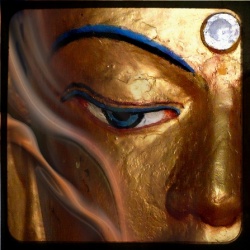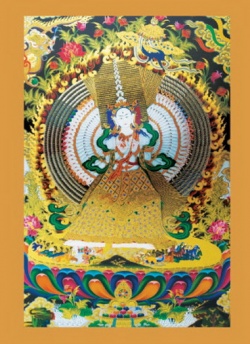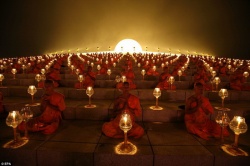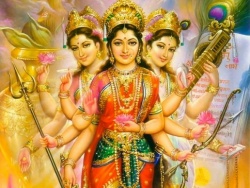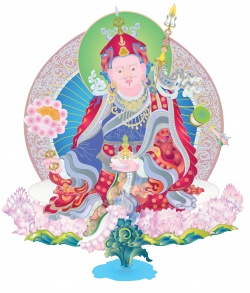The Heart Sutra Will Change You Forever
Penetrate the true meaning of the Heart Sutra, says Karl Brunnhölzl, and nothing will be the same again. The secret is making it personal.
There is no doubt that the Heart Sutra is the most frequently used and recited text in the entire Mahayana Buddhist tradition, which still flourishes in Japan, Korea, Vietnam, Tibet, Mongolia, Bhutan, China, parts of India and Nepal, and, more recently, also in the Americas and Europe. Many people have said many different things about what the Heart Sutra is and what it is not, such as being the heart of wisdom, a statement of how things truly are, the key teaching of the Mahayana, a condensation of all the Prajnaparamita Sutras (the Buddha’s second turning of the wheel of dharma), or an explanation of emptiness in a nutshell. In order to understand the actual words of the Heart Sutra, it’s helpful to first explore its background within the Buddhist tradition as well as the meanings of “prajnaparamita” and “emptiness.”
One thing we can safely say about the Heart Sutra is that it is completely crazy. If we read it, it does not make any sense. Well, maybe the beginning and end make sense, but everything in the middle sounds like a sophisticated form of nonsense, which can be said to be the basic feature of the Prajnaparamita Sutras in general. If we like the word “no,” we might like the sutra because that is the main word it uses—no this, no that, no everything. We could also say that it is a sutra about wisdom, but it is a sutra about crazy wisdom. When we read it, it sounds nuts, but that is actually where the wisdom part comes in. What the Heart Sutra (like all Prajnaparamita Sutras) does is to cut through, deconstruct, and demolish all our usual conceptual frameworks, all our rigid ideas, all our belief systems, all our reference points, including any with regard to our spiritual path. It does so on a very fundamental level, not just in terms of thinking and concepts, but also in terms of our perception, how we see the world, how we hear, how we smell, taste, touch, how we regard and emotionally react to ourselves and others, and so on. This sutra pulls the rug out from underneath our feet and does not leave anything intact that we can think of, nor even a lot of things that we cannot think of. This is called “crazy wisdom.” I guess I should give you a warning here that this sutra is hazardous to your samsaric sanity. What Sangharakshita says about the Diamond Sutra equally applies to all Prajnaparamita Sutras, including the Heart Sutra:
…if we insist that the requirements of the logical mind be satisfied, we are missing the point. What the Diamond Sutra is actually delivering is not a systematic treatise, but a series of sledgehammer blows, attacking from this side and that, to try and break through our fundamental delusion. It is not going to make things easy for the logical mind by putting things in a logical form. This sutra is going to be confusing, irritating, annoying, and unsatisfying—and perhaps we cannot ask for it to be otherwise. If it were all set forth neatly and clearly, leaving no loose ends, we might be in danger of thinking we had grasped the Perfection of Wisdom.
—Sangharakshita, Wisdom Beyond Words
Another way to look at the Heart Sutra is that it represents a very condensed contemplation manual. It is not just something to be read or recited, but the intention is to contemplate its meaning in as detailed a way as possible. Since it is the Heart Sutra, it conveys the heart essence of what is called prajnaparamita, the “perfection of wisdom or insight.” In itself, it does not fuss around, or give us all the details. It is more like a brief memo for contemplating all the elements of our psychophysical existence from the point of view of what we are now, what we become as we progress on the Buddhist path, and what we attain (or do not attain) at the end of that path. If we want to read all the details, we have to go to the longer Prajnaparamita Sutras, which make up about twenty-one thousand pages in the Tibetan Buddhist canon—twenty-one thousand pages of “no.” The longest sutra alone, in one hundred thousand lines, consists of twelve large books. The Heart Sutra is on the lower end, so to speak, and the shortest sutra consists of just one letter, which is my personal favorite. It starts with the usual introduction, “Once the Buddha was dwelling in Rajagriha at Vulture Flock Mountain” and so on, and then he said, “A.” It ends with all the gods and so on rejoicing, and that’s it. It is said that there are people who actually realize the meaning of the Prajnaparamita Sutras through just hearing or reading “A.”
Besides being a meditation manual, we could also say that the Heart Sutra is like a big koan. But it is not just one koan, it is like those Russian dolls: there is one big doll on the outside and then there is a smaller one inside that first one, and there are many more smaller ones in each following one. Likewise, all the “nos” in the big koan of the sutra are little koans. Every little phrase with a “no” is a different koan in terms of what the “no” relates to, such as “no eye,” “no ear,” and so on. It is an invitation to contemplate what that means. “No eye,” “no ear” sounds very simple and very straightforward, but if we go into the details, it is not that straightforward at all. In other words, all those different “no” phrases give us different angles or facets of the main theme of the sutra, which is emptiness. Emptiness means that things do not exist as they seem, but are like illusions and like dreams. They do not have a nature or a findable core of their own. Each one of those phrases makes us look at that very same message. The message or the looking are not really different, but we look at it in relation to different things. What does it mean that the eye is empty? What does it mean that visible form is empty? What does it mean that even wisdom, buddhahood, and nirvana are empty?
From an ordinary Buddhist point of view we could even say that the Heart Sutra is not only crazy, but it is iconoclastic or even heretical. Many people have complained about the Prajnaparamita Sutras because they also trash all the hallmarks of Buddhism itself, such as the four noble truths, the Buddhist path, and nirvana. These sutras not only say that our ordinary thoughts, emotions, and perceptions are invalid and that they do not really exist as they seem to, but that the same goes for all the concepts and frameworks of philosophical schools—non- Buddhist schools, Buddhist schools, and even the Mahayana, the tradition to which the Prajnaparamita Sutras belong. Is there any other spiritual tradition that says, “Everything that we teach, just forget about it”? It is somewhat similar to the boss of Microsoft recently having publicly recommended that PC users should not buy Windows Vista any more, but instead go straight from Windows XP to Windows 7. Basically, he was advertising against his own product. The Heart Sutra is similar to that, except that it tells us only what not to buy, but not what to buy instead.
In brief, if we have never seen the Heart Sutra and we read it, it sounds crazy because it just keeps saying “no, no, no.” If we are trained in Buddhism, it also sounds crazy (maybe even more so) because it negates everything that we have learned and try to cultivate.
The Heart Sutra and the other Prajnaparamita Sutras talk about a lot of things, but their most fundamental theme is the basic groundlessness of our experience. They say that no matter what we do, no matter what we say, and no matter what we feel, we need not believe any of it. There is nothing whatsoever to hold on to, and even that is not sure. So these sutras pull the rug out from under us all the time and take away all our favorite toys. Usually when someone takes away one of our mental toys we just find new toys. That is one of the reasons why many of the Prajnaparamita Sutras are so long—they list all the toys we can think of and even more, but our mind still keeps grasping at new ones. The basic point is to get to a place where we actually stop searching for and grasping at the next toy. Then we need to see how that state of mind feels. How does our mind feel when we are not grasping at anything, when we are not trying to entertain ourselves, and when our mind is not going outside (or not going anywhere at all), when there is no place left to go?
Usually we think that if a given phenomenon is not something, it must be nothing, and if it is not nothing, it must be something. But emptiness is just a word for pointing out the fact that no matter what we say or think about something, it does not really correctly characterize that something because our dualistic mind just gets stuck in one extreme or the other. Thus, we could say that emptiness is like thinking outside of the box, that is, the box of black-and-white thinking or dualistic thinking. As long as we stay within the ballpark of dualistic thinking, there is always existence, nonexistence, permanence, extinction, good, and bad. Within that frame of reference, we will never get beyond it, no matter if we are religious, a scientist, a Buddhist, an agnostic, or whatever. Emptiness tells us that we have to step out of that ballpark altogether. Emptiness points to the most radical transformation of our entire outlook with regard to ourselves and the world. Emptiness not only means the end of the world as we know it, but that this world never really existed in the first place.
Why is it called the “Heart Sutra”? It has that name because it teaches the heart of the Mahayana, primarily in terms of the view. However, the basic motivation of the Mahayana is also implicitly contained in this sutra in the form of Avalokiteshvara, the great bodhisattva who is the embodiment of the loving-kindness and compassion of all buddhas. It is actually the only Prajnaparamita Sutra in which Avalokiteshvara appears at all, and in it he is even the main speaker. Thus, the Heart Sutra teaches emptiness through the epitome of compassion. It is often said that, in a sense, emptiness is the heart of the Mahayana, but the heart of emptiness is compassion. The scriptures even use the phrase “emptiness with a heart of compassion.” It is crucial to never forget that. The main reason for Avalokitesvara’s presence here is to symbolize the aspect of compassion and to emphasize that we should not miss out on it. If we just read all the “nos” and then get hooked on the “no path” of “no self” and “no attainment,” it gets a little dreary or depressing and we may wonder, “Why are we doing this?” or “Why are we not doing this?” In fact, the heart essence of the Prajnaparamita teachings and the Mahayana is the union of emptiness and compassion. If we look at the larger Prajnaparamita Sutras, we see that they teach both aspects extensively. In addition to teaching about emptiness, they also speak about the path in great detail, such as how to cultivate loving-kindness and compassion, how to do certain meditations, and how to progress through the paths. They do not always say “no,” but also sometimes present things in a more positive light. Even the Heart Sutra, toward the end, comes up with a few phrases without “no.”
Without developing a soft heart and compassion, which like water softens our mental rigidity, there is a danger that the teachings on emptiness can make our hearts even harder. If we think we understand emptiness, but our compassion does not increase, or even lessens, we are on the wrong track. Therefore, for those of us who are Buddhists, it is good and necessary to give rise to compassion and bodhichitta before we study, recite, and contemplate this sutra. All others may connect with any spot of compassion that they can find in their hearts.
In yet another way, we could say that the Heart Sutra is an invitation to just let go and relax. We can replace all the words in this sutra that go with “no,” such as “no eye,” “no ear,” with all our problems, such as “no depression,” “no fear,” “no unemployment,” “no war,” and so on. That might sound simplistic, but if we do that and actually make it into a contemplation on what all those things such as depression, fear, war, and economic crisis actually are, it can become very powerful, maybe even more powerful than the original words in the sutra. Usually we are not that interested in, for example, our ears and whether they really exist or not, so with regard to contemplating what emptiness means, one of the basic principles of the Prajnaparamita Sutras is to make the examination as personal as possible. It is not about reciting some stereotypical formula or the Heart Sutra without ever getting to the core of our own clinging to real existence with regard to those phenomena to which we obviously do cling, or our own egoclinging. For example, the Heart Sutra does not say “no self,” “no home,” “no partner,” “no job,” “no money,” which are the things we usually care about. Therefore, in order to make it more relevant to our life, we have to fill those in. The Heart Sutra gives us a basic template of how to contemplate emptiness, but the larger Prajnaparamita Sutras fill in a lot of stuff, not only saying “no eye,” “no ear,” and so on. They go through endless lists of all kinds of phenomena, so we are welcome to come up with our own personal lists of phenomena that map out our personal universe and then apply the approach of the Heart Sutra to those lists.
There are accounts in several of the larger Prajnaparamita Sutras about people being present in the audience who had already attained certain advanced levels of spiritual development or insight that liberated them from samsaric existence and suffering. These people, who are called “arhats” in Buddhism, were listening to the Buddha speaking about emptiness and then had different reactions. Some thought, “This is crazy, let’s go” and left. Others stayed, but some of them had heart attacks, vomited blood, and died. It seems they didn’t leave in time. These arhats were so shocked by what they were hearing that they died on the spot. That’s why somebody suggested to me that we could call the Heart Sutra the Heart Attack Sutra. Another meaning of that could be that this sutra goes right for the heart of the matter, while mercilessly attacking all ego trips that prevent us from waking up to our true heart. In any case, so far nobody has had a heart attack here, which is good news. But the bad news is that probably nobody understood it either.
From The Heart Attack Sutra, by Karl Brunnhölzl, published by Snow Lion, 2012
Karl Brunnhölzl is a senior teacher in the Nalandabodhi community of Dzogchen Ponlop Rinpoche and was recently bestowed the title of khenpo. He is the author and translator of numerous texts, including Luminous Heart, Gone Beyond, and Groundless Paths. This teaching is from his new book, The Heart Attack Sutra, published by Snow Lion, 2012.
